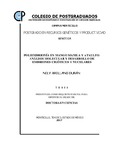| dc.description.abstract | La poliembrionía es una característica importante ya que en una semilla se pueden tener embriones de origen sexual y asexual lo cual da como resultado plantas producto de recombinación genética y clones a la progenitora femenina. En cítricos se ha reportado que plantúlas vigorosas son clones de la madre, lo que se ha generalizado para mango, sin embargo no necesariamente sucede así, por lo cual, se planteó definir el tamaño de muestra óptimo para el estudio de poliembrionía en mango cvs. Manila y Ataulfo, describir características morfológicas de frutos que puedan ser correlacionadas con aspectos de poliembrionía y estimar el porcentaje de plantas idénticas a la progenitora femenina obtenidas del embrión de mayor tamaño por medio de SSRs. Durante 2013 y 2014 se colectaron frutos procedentes de Chiapas, Guerrero y Nayarit. En Chiapas solo se colectó el cv. Ataulfo en 2014. En cada estado se seleccionaron dos huertas y cosecharon frutos de tres árboles por huerta. De acuerdo al método de curvatura máxima, el punto de inflexión en las variables: peso de fruto, semilla, embriones, peso de embrión de mayor tamaño, y número de embriones se determinó como tamaño de muestra óptimo, seis frutos para ambos cultivares y lugares de procedencia. El peso de la semilla fue una característica que sirve en la inferencia del tamaño de los embriones, al igual que del tamaño del embrión más grande. El cv. Manila presentó hasta siete embriones por semilla, y Ataulfo ocho, sin embargo en ambos cultivares fue frecuente encontrar en promedio tres embriones. El color de la radícula es un rasgo distintivo, en el cv. Ataulfo fue de rosado a rojo y en Manila crema. El porcentaje de poliembrionía difiere según el cultivar, localidad y año de evaluación, en el cv. Ataulfo fue superior a 90 % mientras que en Manila fue de 80 %. Los marcadores que mostraron polimorfismos en el cv. Ataulfo fueron: MIAC-5, MIAC-4, mMiCIR003, en el cv. Manila MiSHRS-1+ y en ambos cultivares LMMA1, LMMA9, y mMiCIR030. De acuerdo con dos parámetros de evaluación utilizados, en los cvs Ataulfo y Manila hasta el 10 % de las plantas originadas del embrión de mayor tamaño son diferentes a la progenitora femenina. _______________ POLYEMBRIONY IN MANGO MANILA AND ATAULFO: MOLECULAR ANALYSIS AND DEVELOPMENT OF CIGOTIC AND NUCLEARS EMBRYOS. ABSTRACT: Polyembryony is an important characteristic because in a seed can be had embryos of sexual and asexual origin which results in plants product of genetic recombination and clones to the female progenitor. In citrus fruits it has been reported that vigorous plants are clones of the mother, which has been generalized for mango, however it does not necessarily happen that way, therefore, it was proposed to define the optimal sample size for the study of polyembryony in Mango cvs Manila and Ataulfo, to describe morphological characteristics of fruits that can be correlated with aspects of polyembryony and to estimate the percentage of plants identical to the female progenitor obtained from the larger embryo by means of SSRs. During 2013 and 2014 fruits were collected from Chiapas, Guerrero and Nayarit. In Chiapas, only cv Ataulfo was collected in 2014. In each state, two orchards were harvested and harvested from three trees per orchard. According to the maximum curvature method, the inflection point in the variables: fruit weight, seed, embryos, embryo weight, and number of embryos were determined as optimal sample size, six fruits for both cultivars and places of origin. The weight of the seed was a characteristic that serves in the inference of the size of the embryos, as well as the size of the largest embryo. Manila presented up to seven embryos per seed, and Ataulfo eight, however in both cultivars it was common to find on average three embryos. The color of the radicle is a distinctive feature, in the cultivar Ataulfo was from pink to red and in Manila cream. The percentage of polyembryony differs according to the cultivar, locality and year of evaluation, in cv Ataulfo was higher than 90% while in Manila it was 80%. The markers that showed polymorphisms in cv Ataulfo were: MIAC-5, MIAC-4, mMiCIR003, in the cv Manila MiSHRS-1 + and in both cultivars LMMA1, LMMA9, and mMiCIR030. According to two evaluation parameters used, in the cvs Ataulfo and Manila up to 10% of the plants originated from the larger embryo are different from the female progenitor. | es_MX |


